steering wheel TOYOTA HIGHLANDER HYBRID 2023 Owners Manual
[x] Cancel search | Manufacturer: TOYOTA, Model Year: 2023, Model line: HIGHLANDER HYBRID, Model: TOYOTA HIGHLANDER HYBRID 2023Pages: 572, PDF Size: 14.07 MB
Page 2 of 572

2TABLE OF CONTENTS
For your information ........................5
Reading this manual ...................... 10
How to search ................................ 11
Pictorial index ................................ 12
1-1. For safe use Before driving ........................ 24
For safe driving ..................... 25
Seat belts .............................. 27
SRS airbags .......................... 34
Front passenger occupant clas- sification system.................. 43
Exhaust gas precautions....... 48
1-2. Child safety Riding with children ............... 49
Child restraint systems .......... 50
1-3. Emergency assistance Safety Connect ..................... 65
1-4. Hybrid system Hybrid system features ......... 69
Hybrid system precautions .... 73
1-5. Theft deterrent system Immobilizer system ............... 77
Alarm ..................................... 78
2-1. Instrument cluster Warning lights and indicators............................................ 82
Gauges and meters (7-inch dis- play) .................................... 87
Gauges and meters (12.3-inch display)................................ 91
Multi-information display (7-inch display)................................ 96
Multi-information display (12.3-inch display)............ 106
Head-up display ................. 114Energy monitor/consumption
screen .............................. 119
3-1. Key information Keys ................................... 124
3-2. Opening, closing and locking the doors
Side doors .......................... 127
Back door ........................... 131
Smart key system .............. 142
3-3. Adjusting the seats Front seats ......................... 147
Rear seats.......................... 148
Driving position memory .... 153
Head restraints................... 156
3-4. Adjusting the steering wheel and mirrors
Steering wheel ................... 159
Inside rear view mirror ....... 160
Digital Rearview Mirror....... 161
Outside rear view mirrors ... 171
3-5. Opening, closing the win- dows and moon roof
Power windows .................. 173
Moon roof ........................... 176
Panoramic moon roof......... 179
4-1. Before driving Driving the vehicle.............. 184
Cargo and luggag e............ 19
1
Vehicle load limits .............. 194
Trailer towing...................... 195
Dinghy towing .................... 206
4-2. Driving procedures Power (ignition) switch ....... 207
EV drive mode ................... 211
1For safety and security
2Vehicle status information
and indicators
3Before driving
4Driving
Page 3 of 572

3TABLE OF CONTENTS
1
2
3
4
5
6
7
8
9
10
Hybrid transmission............213
Turn signal lever................. 216
Parking brake ..................... 217
Brake Hold ......................... 220
4-3. Operating the lights and wip- ers
Headlight switch ................. 223
Automatic High Beam ........ 226
Fog light switch .................. 229
Windshield wipers and washer ......................................... 229
Rear windshield wiper and washer ............................. 232
4-4. Refueling Opening the fuel tank cap .. 234
4-5. Using the driving support sys- tems
Toyota Safety Sense 2.5 +......................................... 237
PCS (Pre-Collision System) ......................................... 242
LTA (Lane Tracing Assist)... 253
Dynamic radar cruise control with full-speed range ........ 263
RSA (Road Sign Assist) ..... 275
BSM (Blind Spot Monitor)... 278
Intuitive parking assist ........ 283
RCTA (Rear Cross Traffic Alert) function ............................ 291
PKSB (Parking Support Brake) ......................................... 297
Parking Support Brake function (static objects) .................. 304
Parking Support Brake function (rear-crossing vehicles).... 307
Driving mode select switch ......................................... 308
Trail Mode .......................... 309
Driving assist systems........ 311
4-6. Driving tips Hybrid Electric Vehicle driving tips ................................... 318Winter driving tips ..............
320
Utility vehicle precautions .. 323
5-1. Using the air conditioning system and defogger
Front automatic air conditioning
system ............................. 328
Rear automatic air conditioning system ............................. 337
Heated steering wheel/seat heaters/seat ventilators.... 341
5-2. Using the interior lights Interior lights list ................. 343
5-3. Using the storage features List of storage features ...... 346
Luggage compartment features ......................................... 350
5-4. Using the other interior fea- tures
Other interior features ........ 355
Garage door opener........... 370
6-1. Maintenance and care Cleaning and protecting the vehicle exterior................. 380
Cleaning and protecting the vehicle interi or.................. 38
3
6-2. Maintenance Maintenance requirements......................................... 386
General maintenance......... 388
Emission inspection and mainte- nance (I/M) programs ...... 390
6-3. Do-it-yourself maintenance Do-it-yourself service precau-tions ................................. 392
Hood .................................. 394
5Interior features
6Maintenance and care
Page 17 of 572

17Pictorial index
■Switches
Driving position memory switches*1................................ P.153
Window lock switch ............................................. .............. P.175
Power window switches ....... ............................................. P.173
Door lock switches ............................................................ P.130
Outside rear view mirror swi tches ................................... P.171
“ODO TRIP” switch .............................................. ................ P.89
Instrument panel light control switches ........................ .... P.89
Automatic High Beam switch ..................................... ...... P.226
Camera switch
*1, 2
“AC120V” switch*1............................................................. P. 364
Power back door switch ... ................................................. P.133
Heated steering wheel switch
*1........................................ P.341
*1: If equipped
*2: Refer to “MULTIMEDIA OWNER’S MANUAL”.
Page 25 of 572
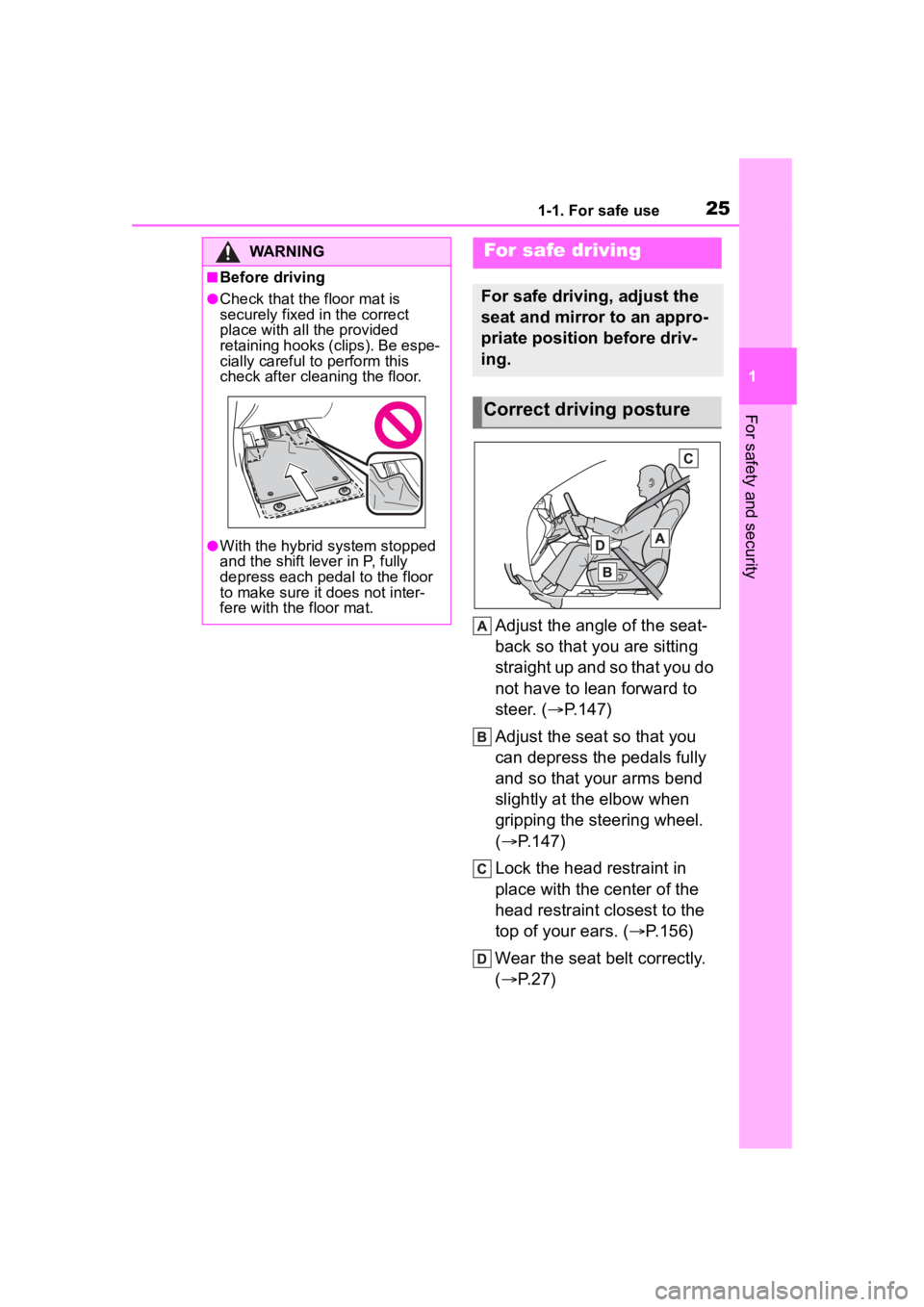
251-1. For safe use
1
For safety and security
Adjust the angle of the seat-
back so that you are sitting
straight up and so that you do
not have to lean forward to
steer. (P.147)
Adjust the seat so that you
can depress the pedals fully
and so that your arms bend
slightly at the elbow when
gripping the steering wheel.
( P.147)
Lock the head restraint in
place with the center of the
head restraint closest to the
top of your ears. ( P.156)
Wear the seat belt correctly.
( P.27)
WARNING
■Before driving
●Check that the floor mat is
securely fixed in the correct
place with all the provided
retaining hooks (clips). Be espe-
cially careful to perform this
check after cleaning the floor.
●With the hybrid system stopped
and the shift lever in P, fully
depress each pedal to the floor
to make sure it does not inter-
fere with the floor mat.
For safe driving
For safe driving, adjust the
seat and mirror to an appro-
priate position before driv-
ing.
Correct driving posture
Page 39 of 572
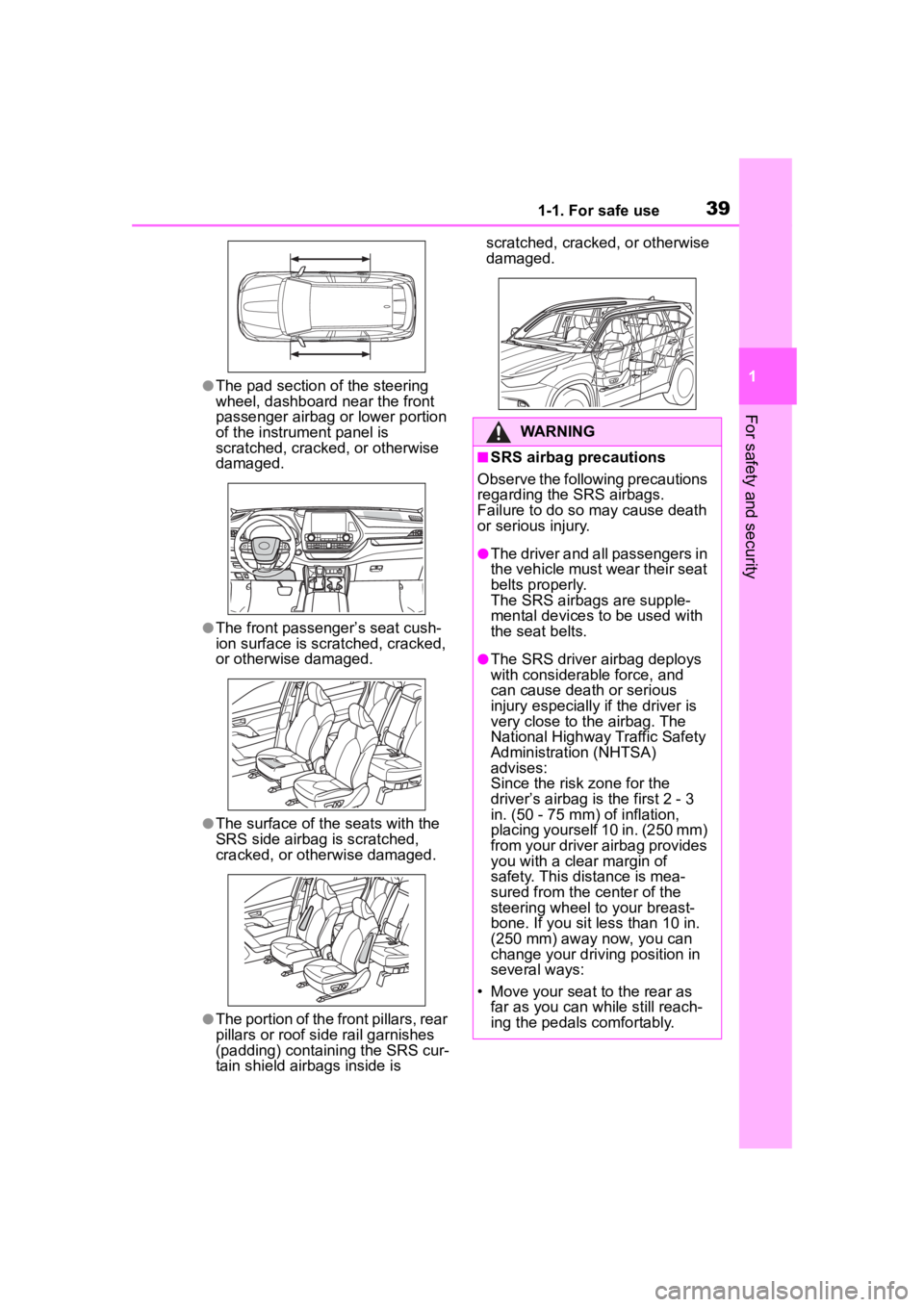
391-1. For safe use
1
For safety and security
●The pad section of the steering
wheel, dashboard near the front
passenger airbag or lower portion
of the instrument panel is
scratched, cracked, or otherwise
damaged.
●The front passenger’s seat cush-
ion surface is scratched, cracked,
or otherwise damaged.
●The surface of the seats with the
SRS side airbag is scratched,
cracked, or otherwise damaged.
●The portion of the front pillars, rear
pillars or roof side rail garnishes
(padding) containing the SRS cur-
tain shield airbags inside is scratched, cracked, or otherwise
damaged.
WARNING
■SRS airbag precautions
Observe the following precautions
regarding the SRS airbags.
Failure to do so may cause death
or serious injury.
●The driver and all passengers in
the vehicle must wear their seat
belts properly.
The SRS airbags are supple-
mental devices to be used with
the seat belts.
●The SRS driver airbag deploys
with considerable force, and
can cause death or serious
injury especially if the driver is
very close to the airbag. The
National Highway Traffic Safety
Administration (NHTSA)
advises:
Since the risk zone for the
driver’s airbag is the first 2 - 3
in. (50 - 75 mm) of inflation,
placing yourself 10 in. (250 mm)
from your driver airbag provides
you with a clear margin of
safety. This distance is mea-
sured from the c enter of the
steering wheel to your breast-
bone. If you sit less than 10 in.
(250 mm) away now, you can
change your driv ing position in
several ways:
• Move your seat to the rear as far as you can while still reach-
ing the pedals comfortably.
Page 40 of 572
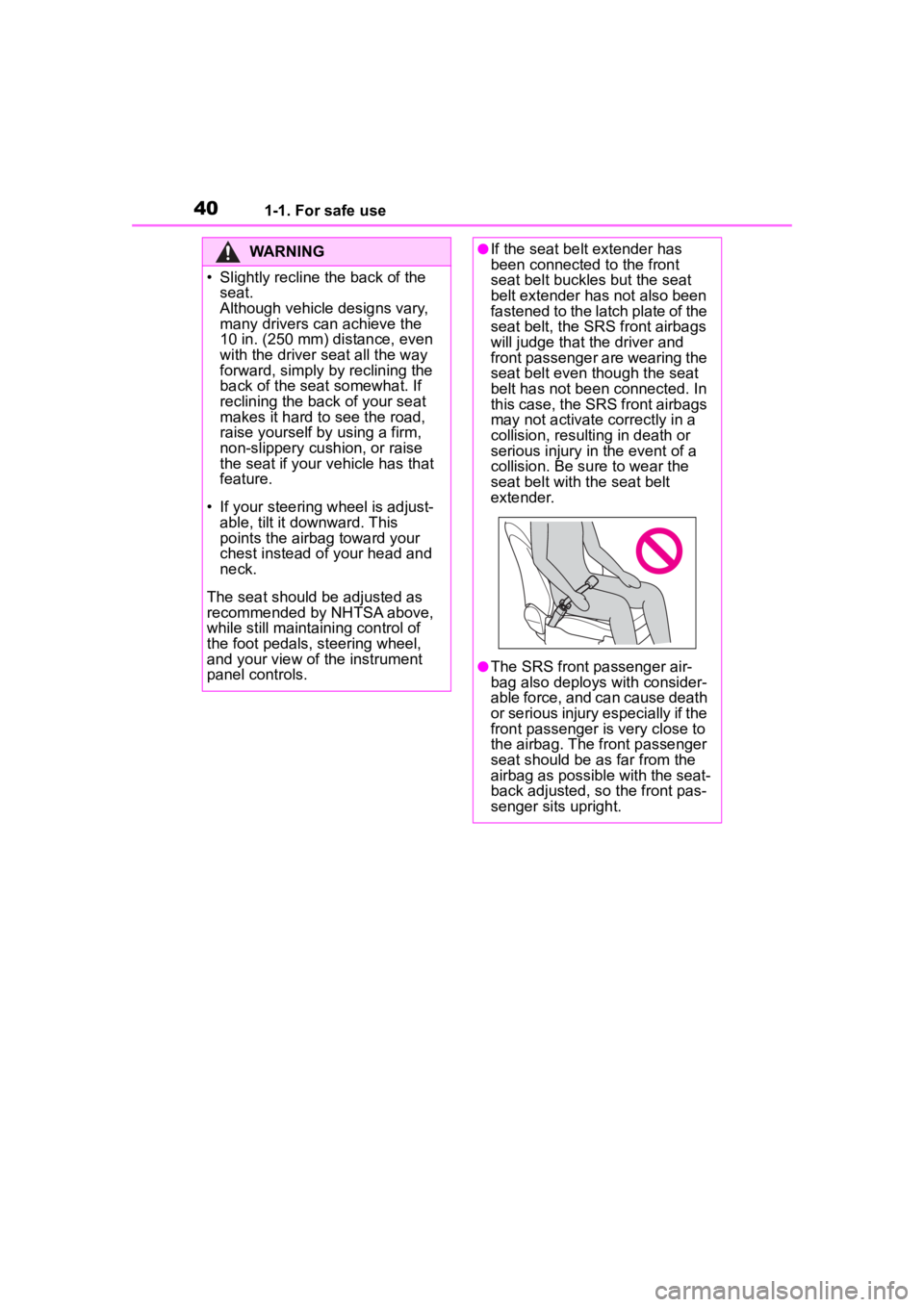
401-1. For safe use
WARNING
• Slightly recline the back of the seat.
Although vehicle designs vary,
many drivers can achieve the
10 in. (250 mm) distance, even
with the driver seat all the way
forward, simply by reclining the
back of the seat somewhat. If
reclining the back of your seat
makes it hard to see the road,
raise yourself by using a firm,
non-slippery cushion, or raise
the seat if your vehicle has that
feature.
• If your steering wheel is adjust- able, tilt it downward. This
points the airbag toward your
chest instead of your head and
neck.
The seat should be adjusted as
recommended by NHTSA above,
while still maintaining control of
the foot pedals, steering wheel,
and your view of the instrument
panel controls.
●If the seat belt extender has
been connected to the front
seat belt buckles but the seat
belt extender has not also been
fastened to the latch plate of the
seat belt, the SRS front airbags
will judge that the driver and
front passenger are wearing the
seat belt even though the seat
belt has not been connected. In
this case, the SRS front airbags
may not activate correctly in a
collision, resulting in death or
serious injury in the event of a
collision. Be su re to wear the
seat belt with the seat belt
extender.
●The SRS front passenger air-
bag also deploys with consider-
able force, and can cause death
or serious injury especially if the
front passenger is very close to
the airbag. The front passenger
seat should be as far from the
airbag as possible with the seat-
back adjusted, so the front pas-
senger sits upright.
Page 41 of 572
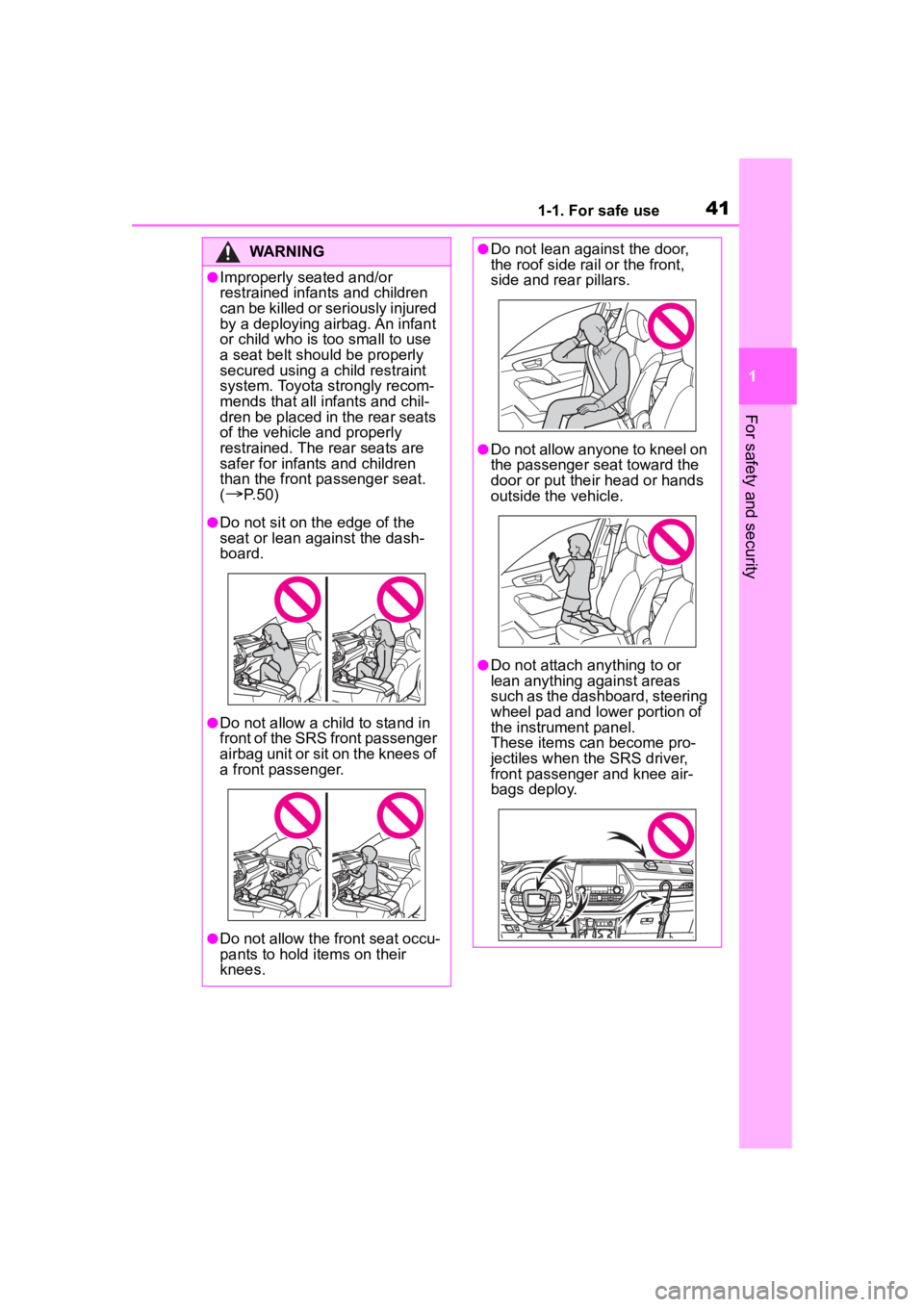
411-1. For safe use
1
For safety and security
WARNING
●Improperly seated and/or
restrained infants and children
can be killed or seriously injured
by a deploying airbag. An infant
or child who is too small to use
a seat belt should be properly
secured using a child restraint
system. Toyota strongly recom-
mends that all infants and chil-
dren be placed in the rear seats
of the vehicle and properly
restrained. The rear seats are
safer for infants and children
than the front passenger seat.
(
P. 5 0 )
●Do not sit on the edge of the
seat or lean against the dash-
board.
●Do not allow a child to stand in
front of the SRS front passenger
airbag unit or sit on the knees of
a front passenger.
●Do not allow the front seat occu-
pants to hold items on their
knees.
●Do not lean against the door,
the roof side rail or the front,
side and rear pillars.
●Do not allow anyone to kneel on
the passenger seat toward the
door or put their head or hands
outside the vehicle.
●Do not attach anything to or
lean anything against areas
such as the dashboard, steering
wheel pad and lower portion of
the instrument panel.
These items can become pro-
jectiles when th e SRS driver,
front passenger and knee air-
bags deploy.
Page 42 of 572

421-1. For safe use
WARNING
●Do not attach anything to areas
such as a door, windshield, side
windows, front or rear pillar, roof
side rail and assist grip.
●Do not hang coat hangers or
other hard objects on the coat
hooks. All of these items could
become projectiles and may
cause death or serious injury,
should the SRS curtain shield
airbags deploy.
●If a vinyl cover is put on the area
where the SRS knee airbag will
deploy, be sure to remove it.
●Do not use seat accessories
which cover the parts where the
SRS side airbags and SRS seat
cushion airbag inflate as they
may interfere with inflation of
the SRS airbags. Such acces-
sories may prevent the side air-
bags and seat cushion airbag
from activating correctly, disable
the system or cause the side
airbags and seat cushion airbag
to inflate accidentally, resulting
in death or serious injury.
●Do not strike or apply significant
levels of force to the area of the
SRS airbag components or the
front doors. Doing so can cause
the SRS airbags to malfunction.
●Do not touch any of the compo-
nent parts immediately after the
SRS airbags have deployed
(inflated) as they may be hot.
●If breathing becomes difficult
after the SRS airbags have
deployed, open a door or win-
dow to allow fresh air in, or
leave the vehicle if it is safe to
do so. Wash off any residue as
soon as possible to prevent skin
irritation.
●If the areas where the SRS air-
bags are stored, such as the
steering wheel pad and front
and rear pillar garnishes, are
damaged or cracked, have
them replaced by your Toyota
dealer.
●Do not place anything, such as
a cushion, on the front passen-
ger’s seat. Doing so will
disperse the passenger’s
weight, which prevents the sen-
sor from detecting the passen-
ger’s weight properly. As a
result, the SRS front airbags for
the front passenger may not
deploy in the event of a colli-
sion.
■Modification and disposal of
SRS airbag system compo-
nents
Do not dispose of your vehicle or
perform any of the following modi-
fications without consulting your
Toyota dealer. The SRS airbags
may malfunction or deploy
(inflate) accidentally, causing
death or serious injury.
●Installation, re moval, disassem-
bly and repair of the SRS air-
bags
●Repairs, modific ations, removal
or replacement of the steering
wheel, instrument panel, dash-
board, seats or seat upholstery,
front, side and rear pillars, roof
side rails, front door panels,
front door trims or front door
speakers
Page 102 of 572
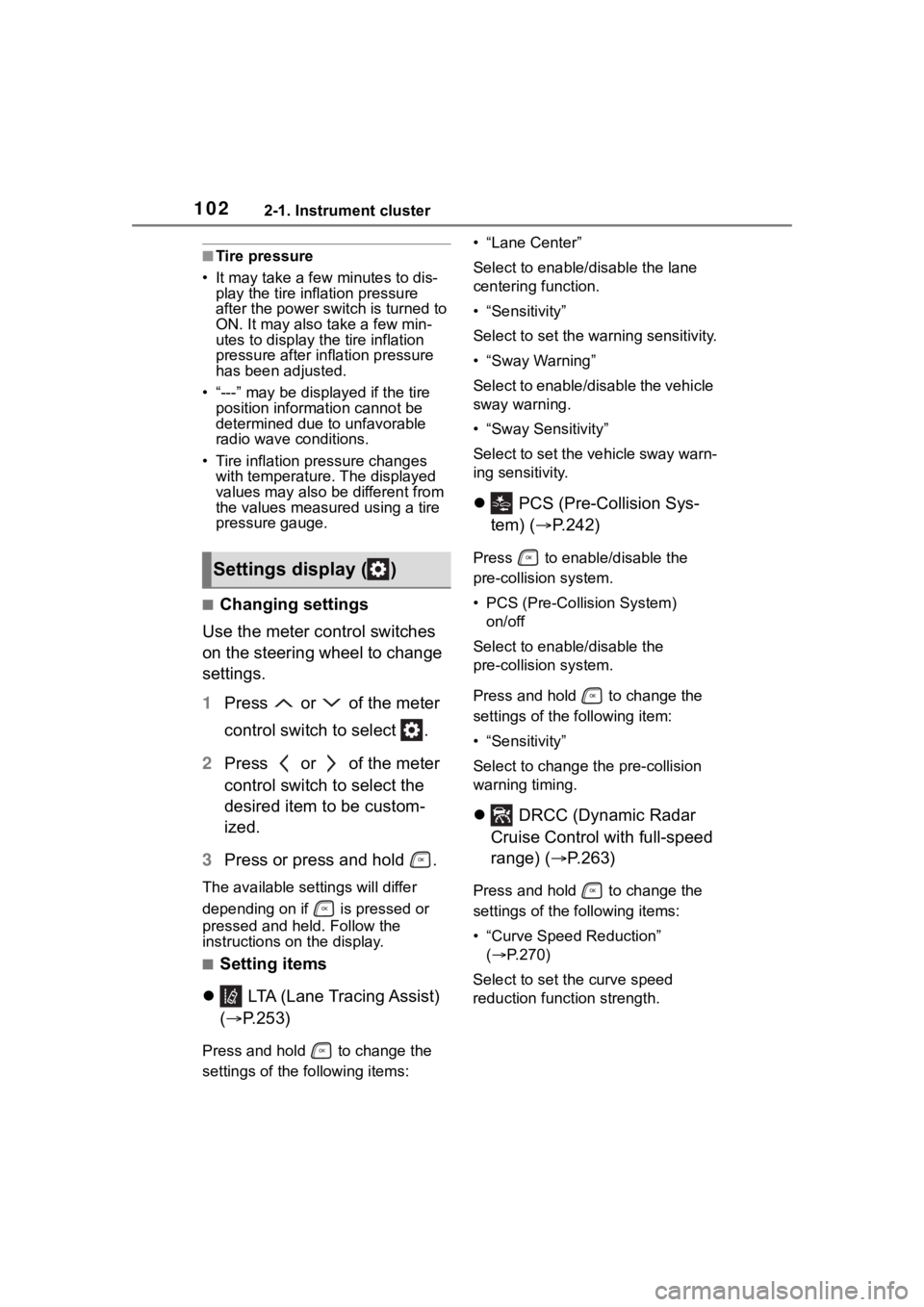
1022-1. Instrument cluster
■Tire pressure
• It may take a few minutes to dis- play the tire inflation pressure
after the power switch is turned to
ON. It may also take a few min-
utes to display the tire inflation
pressure after inflation pressure
has been adjusted.
• “---” may be disp layed if the tire
position information cannot be
determined due to unfavorable
radio wave conditions.
• Tire inflation pressure changes with temperature. The displayed
values may also be different from
the values measured using a tire
pressure gauge.
■Changing settings
Use the meter control switches
on the steering wheel to change
settings.
1 Press or of the meter
control switch to select .
2 Press or of the meter
control switch to select the
desired item to be custom-
ized.
3 Press or press and hold .
The available settings will differ
depending on if is pressed or
pressed and held. Follow the
instructions on the display.
■Setting items
LTA (Lane Tracing Assist)
( P.253)
Press and hold to change the
settings of the following items: • “Lane Center”
Select to enable
/disable the lane
centering function.
• “Sensitivity”
Select to set the warning sensitivity.
• “Sway Warning”
Select to enable/disable the vehicle
sway warning.
• “Sway Sensitivity”
Select to set the vehicle sway warn-
ing sensitivity.
PCS (Pre-Collision Sys-
tem) ( P.242)
Press to enable/disable the
pre-collision system.
• PCS (Pre-Collision System)
on/off
Select to enable/disable the
pre-collision system.
Press and hold to change the
settings of the following item:
• “Sensitivity”
Select to change the pre-collision
warning timing.
DRCC (Dynamic Radar
Cruise Control with full-speed
range) ( P.263)
Press and hold to change the
settings of the following items:
• “Curve Speed Reduction”
( P.270)
Select to set the curve speed
reduction function strength.
Settings display ( )
Page 119 of 572

1192-1. Instrument cluster
2
Vehicle status information and indicators
■Pop-up displays
Depending on the pop-up display,
the currently disp layed item in the
message display area may be tem-
porarily not displayed. The item will
be displayed after the pop-up dis-
play is no longer displayed.
Audio system screen
Multi-information display
Meter control switches
■Multi-information display
Press the meter control
switches on the steering wheel
several times to select the
energy monitor display.
■Audio system screen
1 Select on the main menu.
2 Select “Energy flow”.
■Reading the display
The arrows will appear in accor-
dance with the energy flow.
When there is no energy flow,
Energy monitor/con-
sumption screen
The state of the hybrid sys-
tem can be viewed on the
multi-information display
and audio system display.
System components
Energy monitor